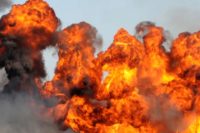The spectacle of frightened elderly nursing home patients being rescued from debris following last week’s explosion at a Texas fertilizer plant had a jarring affect on many Americans. So did photos of debris where approximately 80 homes once stood, and pictures of an apartment complex that had its windows blasted out by the explosion.
In the wake of the West Fertilizer Co. incident that killed 14 people, Texas legislators plan to investigate how many of the state’s 592 fertilizer plants are located near homes, schools and businesses.
Rep. Joe Pickett, chairman of the House Homeland Security and Public Safety Committee that will conduct the inquiry, said it was important to determine where similar accidents might occur.
"We need to learn how many possibilities there are out there," said the El Paso. "I imagine Texans are driving by those places every day and don't know it."
State officials have admitted to not knowing where other high hazard plants are located, although it’s likely that some are in populated areas.
Fertilizer plants with more than 400 pounds of ammonium nitrate are required to report to the Department of Homeland Security (ammonium nitrate can be used in making bombs), yet Reuters reported on April 20th that West Fertilizer "did not tell [DHS] about the potentially explosive fertilizer as it is required to do, leaving one of the principle regulators of ammonium nitrate ... unaware of any danger there."
Reuters quoted Rep. Bennie Thompson (D-MS) as saying, "It seems this manufacturer was willfully off the grid. ... This facility was known to have chemicals well above the threshold amount ... yet we understand that DHS did not even know the plant existed until it blew up."
The National Council for Occupational Safety and Health (National COSH) has accused West Fertilizer of downplaying the risks at its facility to the EPA and of failing to have a Process Safety Management plan in place -- something required by OSHA when hazardous chemicals are present.

